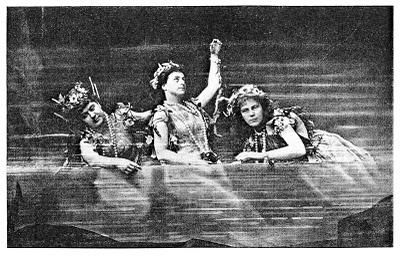
Josef Hoffmann: Das Rheingold
This past week, the Beloved Flatmate and I enjoyed the rarity of a Friday night out... listening to a talk on staging the Ring! Thanks to the Met Opera student program, this was free of charge for us; it may have been for the larger public as well, but I wasn't able to find that information. Our entertaining (yes, really) and informative speaker was William Berger, author of, inter alia, Wagner Without Fear. Mr. Berger, diplomatic throughout, offered a historical overview of Ring stagings, divided into three categories, which he purposefully created and compromised almost in the same breath. (The Beloved Flatmate and I were taking mental notes on pedagogy, too.) Our three sample productions were all from Bayreuth: 1876, Josef Hoffmann; 1951, Wieland Wagner; and 1976, Patrice Chéreau. They were characterized, respectively, as representative, abstract, and conceptual... but before we got too far into all that, we began, appropriately enough, in the River Rhine.

Patrice Chereau: Die Walkuere
Mr. Berger was (I thought) pitching to an audience presumed to have heard much of Wagner's music, but not necessarily to know a great deal about the history of Wagner relative to the development of opera (or music-drama,) and almost certainly to be suspicious of stagings without trees where the libretto calls for trees. This meant, of course, that a great deal was left out, and there were a number of us in the audience, I suspect (including Superconductor) who would have been very happy to continue dissecting Wagner all weekend... all week... till the Siegfried premiere.... As it was, thanks to the engaging style and patent enthusiasm of the lecture, I enjoyed myself even when I wasn't taking in new information. The three mix-and-match categories from which contemporary directors of Wagner have to draw were characterized as follows: representative stagings, obviously, have trees which look like trees, spears like spears, and dragons like dragons. Abstract stagings reject the never-quite-possible realism (a rainbow bridge? the end of the world in fire and water?) in favor of trying to get at the ideas at the heart of the narrative. Conceptual stagings interpret the Ring through the lens of some outside narrative or, um, concept: environmentalism, capitalism, feminism... you get the idea, and you've probably seen at least one of the productions. M. Owen Lee was alluded to by name, as was Francesca Zambello. Derrida, although not mentioned by name, was very much present: il n'y a pas de hors-texte! ...or is there? Wieland Wagner: Siegfried Robert Lepage's Ring staging, despite being that freshest, I imagine, in the memories of most present, was passed over in silence until the Q&A. Mr. Berger's diplomatic reply to the demand to know what he thought of it was that Ring productions were easy to misjudge midstream. I should add that, although Lepage was not specifically mentioned in the lecture, the current era of production, with comfortable mixing of narrative styles and aesthetics, was enthusiastically hailed by Mr. Berger for its creative potential. Numbers of the audience appeared unconvinced. One respondent referred to "that terrible thing in Los Angeles" without mentioning Achim Freyer by name. I had one of my fantasies of leaping over rows of seats to persuade people, in this case by shoving Likely Impossibilities in their face. The question of how vocal timbre and style affected the interpretation of the Ring was also raised... would that we had had time to discuss it! The Beloved Flatmate and I have added Mr. Berger to the list of music world notables we want to buy drinks over which to discuss opera, with the ulterior motive of absorbing their talents by osmosis.The bon mot of the evening was offered in response to an almost tangible hostility towards images of the 1974 "Space-Age" Ring from Cassel: "I have a theory that operas have always been set in outer space: this exotic place where everything looks different, everything is done differently, and just about anything can happen. It's just that the eighteenth and nineteenth centuries called this place Seville." |

